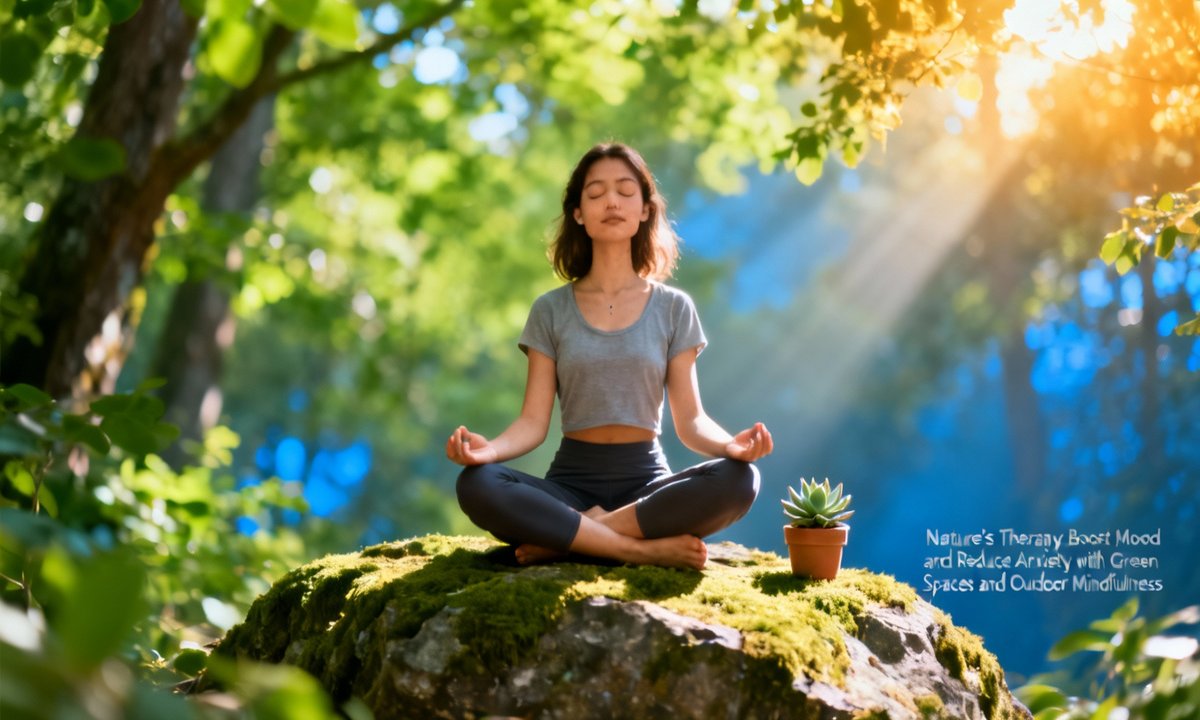In our busy modern lives, millions experience stress and anxiety annually. As emotional distress increases, many are seeking natural, accessible ways to support their mental well-being. Studies indicate that exposure to nature offers numerous benefits, including improved attention, lower stress levels, and a better mood. Nature’s influence on our mental health is increasingly recognized by science and health professionals.
Nature therapy provides an evidence-backed approach to enhance mood and reduce anxiety. It is becoming a popular solution, supported by extensive research and advocates for public health. Discover how green spaces and outdoor mindfulness can become powerful, practical tools for fostering healing and happiness in your life.
The Science Behind Nature and Mental Health
Green spaces, encompassing city parks, gardens, and forests, offer more than just aesthetic beauty. Engaging with nature actively lowers stress levels, reduces the stress hormone cortisol, and improves mood in people of all ages. Studies consistently show these positive physiological changes.
Furthermore, structured nature-based therapy programs have demonstrated significant effectiveness in alleviating anxiety, depression, and stress. They often show superior results compared to traditional control groups, highlighting their therapeutic potential. This confirms the growing scientific support for green space interventions for mental health.
The benefits of nature extend to physical health as well, helping to lower blood pressure and foster increased feelings of calm. Regular participation in outdoor activities builds long-term emotional resilience. Our inherent natural affinity for the outdoors, known as the “biophilia effect,” drives these positive responses.
Why Nature Therapy is So Effective
Even brief excursions into a green space, lasting just 10 to 30 minutes, can noticeably enhance well-being and mood. These short visits help reduce cognitive fatigue and lessen repetitive negative thoughts. They also cultivate a stronger sense of presence, which is vital for managing anxiety effectively. The impact is profound and immediate.
One remarkable aspect of nature therapy is its widespread accessibility. People from all backgrounds, whether living in bustling cities or quiet rural areas, can benefit from spending time outdoors. Innovative programs are now addressing disparities in mental health by enhancing access to green spaces for underserved communities.
Outdoor Mindfulness: Techniques and Best Practices
Outdoor mindfulness merges the therapeutic qualities of green spaces with proven attention-training methods. Practices like mindful walking, forest bathing, and open-air meditation encourage you to pause and observe your surroundings. This helps ground your mind in the present moment, effectively interrupting cycles of worry and stress. It’s a powerful way to reset your mental state.
Engaging in guided outdoor mindfulness can significantly lessen anxiety while enhancing feelings of gratitude and joy. You don’t need prior meditation experience; simply noticing the breeze, sunlight, or the earth’s scent can bring about a profound positive shift in your outlook. Try incorporating these simple observations into your routine.
If you are exploring mindfulness for the first time, our mindfulness practices guide offers easy-to-follow steps suitable for any green walk or backyard experience. Integrate this practice into your daily life to personally feel its uplifting and calming effects.
Real-World Benefits of Mindful Nature Engagement
Consistent outdoor mindfulness strengthens your bond with the natural world, a connection that research associates with heightened life satisfaction and resilience. Even short, mindful moments can foster improved sleep, a more optimistic outlook, and a lasting sense of calm. These benefits are well-documented.
This practice also complements efforts to create calming home environments. Consider cultivating an indoor oasis with plants to extend nature’s therapeutic influence inside your home. Discover more about designing healthier living spaces by exploring guides on beneficial indoor plants for well-being.
Getting Started with Nature Therapy
Accessing nature’s therapeutic benefits doesn’t require a remote wilderness or costly retreats. Begin with easily accessible options, such as your neighborhood park, a local community garden, or even your own backyard. Simply sitting near a potted plant can initiate the process of reducing anxiety and elevating your mood. The simplest steps can be profound.
Consider these straightforward ways to integrate nature into your routine: take a mindful walk around your neighborhood, establish a daily “sit spot” for reflection outdoors, or engage in hands-on gardening, even with small windowsill herbs. These practices help foster a deeper connection to nature.
Gardening stands out as a particularly potent form of outdoor mindfulness. It blends gentle physical activity, tactile experiences, and focused attention, all known to decrease stress. If you are keen on cultivating your own green oasis, our beginner-friendly guide can help you start your plant care journey.
Ensuring Safety, Access, and Adaptability in Nature Therapy
Prioritizing safety is essential when engaging with nature. Opt for public parks or community gardens that are well-maintained and frequently visited. Always remember sun protection and comfortable footwear. Nature therapy is inherently adaptable, so tailor activities to suit any mobility or sensory requirements you may have.
Many individuals find significant relief simply by taking a moment of pause under a neighborhood tree. The key is to make your outdoor experience comfortable and secure, allowing for truly restorative moments in nature’s embrace. Adaptability ensures that everyone can participate.
Accessing Green Spaces: Tips for Everyone
Ensuring equitable mental health means addressing accessibility to green spaces. While urban dwellers and those with mobility issues might face challenges, innovative solutions are making nature therapy available to everyone. Many U.S. cities provide green space directories; a good starting point is your local parks department or the National Park Service.
For those with private outdoor areas, consider designing a backyard haven that boosts mood and supports local biodiversity. Even small spaces like window boxes, balcony gardens, and community plots can bring the profound benefits of nature into your daily life.
Nature’s Presence for City Dwellers and Apartment Residents
City residents and those in apartments can seek out micro-parks, rooftop gardens, or designated green walking paths nearby. Many municipalities now actively promote therapeutic community gardens and green corridors, often freely accessible. Using portable seating and sun hats can make these urban oases enjoyable all year long.
When outdoor access is limited, you can still invite nature indoors. Incorporate indoor plants or adorn your space with natural images and calming sounds. Our guide on bringing nature indoors provides valuable tips for cultivating a serene sanctuary within any living space.
Your Next Steps for Outdoor Wellbeing
Integrating nature therapy into your life for mental health is straightforward, cost-free, and remarkably effective. To make it a daily practice, consider these practical steps:
Dedicate a few minutes each day to a mindful outdoor break, even if it’s just five minutes. Explore joining or forming a local nature group for regular walks or gardening sessions. Experiment with outdoor meditation, forest bathing, or mindful breathing under the canopy of a tree. Share your outdoor experiences with loved ones, as nature therapy often becomes even more impactful when shared.
Increasingly, healthcare providers are endorsing “nature prescriptions” to address anxiety and stress. Speak with your doctor or therapist about how to effectively incorporate outdoor mindfulness into your personalized mental health routine. This emerging trend reflects nature’s proven benefits.
Sustaining Your Nature Connection for Lasting Wellness
The most beneficial nature therapy is one that you genuinely enjoy and can maintain consistently. Discover various green spaces—whether parks, waterfronts, or community gardens—to find what truly brings you a sense of renewal. Adjust your practice for changing weather, seasons, or even bring elements indoors on certain days.
For those interested in enhancing their home environment with sustainable, calming improvements, explore our eco-chic home decor ideas. Additionally, for more support, refer to our resources on stress management tips and evidence-based mental health support. Deepen your wellbeing by fostering connections with both nature and our community.
Conclusion: Step Outside and Start Today
To effectively boost your mood and alleviate anxiety, make regular mindful breaks in green spaces a priority. Whether it’s a tranquil forest, your local park, or a vibrant community garden, aim for at least a few minutes daily. Observe the positive shifts in your overall well-being as you embrace these moments.
Share your experiences with others and continue to explore new outdoor mindfulness activities. Allow nature’s profound therapy to become a vital, joyful component of your life, transforming your well-being one deliberate step outdoors at a time.



